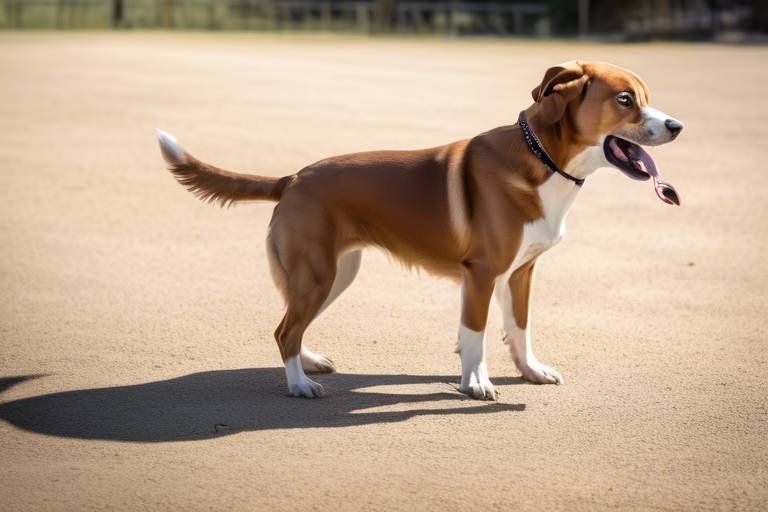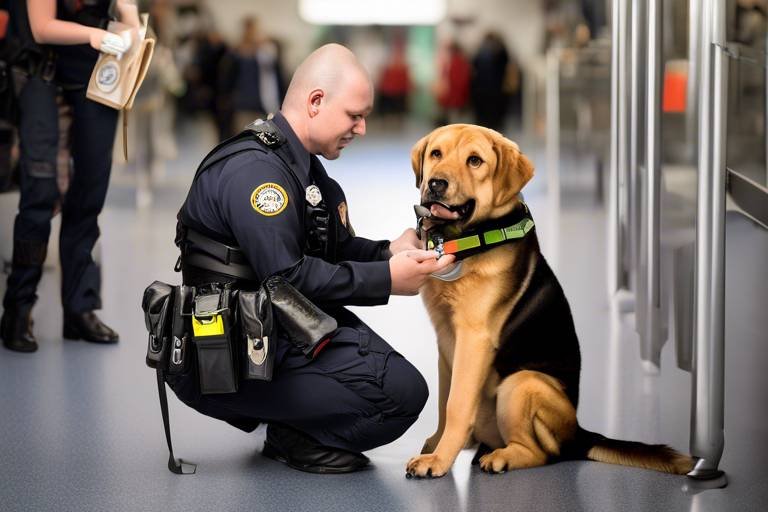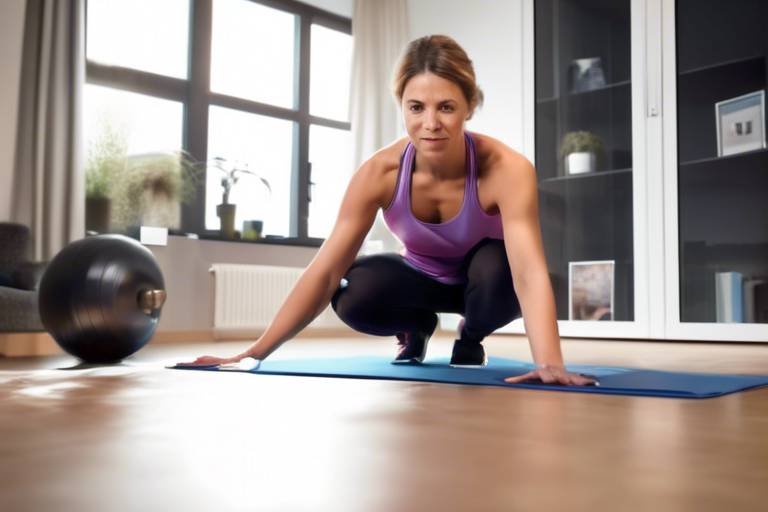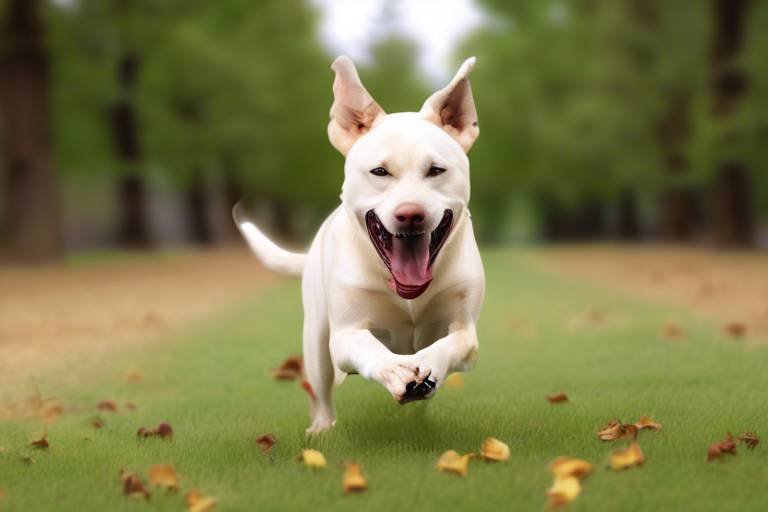How to Teach Your Dog to Go to Their Spot
Training your dog to go to their designated spot on command is not just a fun trick; it’s an essential part of creating a peaceful home environment. Imagine having a well-behaved pup who knows exactly where to go when guests arrive or when you need a moment of calm. Sounds dreamy, right? Well, with the right techniques and a bit of patience, you can turn that dream into reality. This article dives deep into effective methods and tips to help your furry friend understand their 'spot' and make your life a whole lot easier.
So, what exactly is a 'spot' for your dog? In simple terms, it's a specific place where your dog can feel safe and comfortable, and where you want them to go when given the command. Having a designated spot is crucial for several reasons. Firstly, it provides your dog with a sense of security, knowing they have their own little corner of the world. Secondly, it helps establish boundaries and routines, which are vital for a well-adjusted pet. Think of it as their personal sanctuary where they can chill out and relax, away from the hustle and bustle of daily life.
Now that we understand the importance of a spot, let’s talk about how to choose the right one. Selecting a comfortable and safe location for your dog is vital for effective training. You want a place that feels cozy and inviting to them. Here are some factors to consider:
When examining the environment where your dog will stay, consider the following:
- Noise Levels: Is it a quiet area? Dogs can be easily distracted by loud sounds, so a calm environment is ideal.
- Distractions: Look for a spot that minimizes distractions. Too much activity around can make it hard for your dog to focus.
- Accessibility: Ensure that the spot is easily accessible for your dog. If they have to navigate obstacles, they might get discouraged.
Deciding whether to set up an indoor or outdoor spot can significantly influence your dog’s training. Each option has its pros and cons:
| Indoor Spot | Outdoor Spot |
|---|---|
| Controlled environment, less distraction | Fresh air and natural surroundings |
| Protected from weather conditions | More space to roam and explore |
| Can be cozy with bedding | May require supervision for safety |
Think about your dog’s personality and preferences when making this decision. Some dogs thrive indoors, while others love the outdoors.
Above all, ensuring your dog's spot is comfortable and safe is paramount. You can create a welcoming environment by adding appropriate bedding, toys, and even a blanket. If you choose an outdoor spot, make sure it’s protected from harsh weather elements. Think of it as preparing a little retreat for your dog where they can feel at ease, just like how you would set up your favorite reading nook!
Once you’ve chosen the perfect spot, it’s time to establish a clear training process. Start by introducing your dog to the spot using enticing treats or their favorite toy. Make it a positive experience. Gradually guide them to the spot, using a consistent command like “Go to your spot!” Remember, patience is key. It might take a few tries, but with consistency and encouragement, your dog will catch on.
Positive reinforcement is one of the most powerful tools in dog training. When your dog successfully goes to their spot, shower them with praise, treats, or even a fun play session. This not only encourages them to repeat the behavior but also strengthens the bond between you and your pet. Think of it as a high-five for your dog when they do something right!
Understanding the importance of timing and consistency in training can lead to better results. Try to maintain a regular training schedule, and be consistent with your commands and rewards. This helps your dog understand what is expected of them. Imagine learning a new skill; wouldn’t it be confusing if the rules changed every time?
Training can come with its challenges. Your dog might be reluctant to go to their spot or may get distracted easily. But don’t worry! Here are some common issues and practical solutions:
- Issue: Dog ignores the command.
Solution: Use higher-value treats or toys to grab their attention. - Issue: Dog gets distracted by other things.
Solution: Choose a quieter time for training sessions.
With patience and a little creativity, you can overcome these hurdles and make training a fun experience for both you and your dog.
Q: How long will it take for my dog to learn this command?
A: Every dog is different, but with consistent training, most dogs will begin to understand the command within a few weeks.
Q: Can I use any spot for training?
A: It’s best to choose a spot that is comfortable, safe, and free from distractions to enhance the training experience.
Q: What if my dog doesn’t want to go to their spot?
A: Make the spot more appealing with treats or toys and try to associate it with positive experiences.

Understanding the Concept of a Spot
When we talk about a "spot" for your dog, we're not just referring to a physical location; it's about creating a sense of security and comfort for your furry friend. A designated spot acts as a safe haven where your dog can retreat when they need some quiet time or when they feel overwhelmed. Think of it as their personal space, much like how we all cherish our cozy corners in the house. This understanding is crucial because it sets the foundation for effective training.
Establishing a spot helps in several ways. For starters, it provides a clear boundary for your dog, making it easier for them to understand where they should go when you give the command. This clarity is essential in preventing confusion, especially in a bustling household. Imagine trying to concentrate in a noisy café; having a designated area to focus can make all the difference. Similarly, your dog will appreciate having their own spot to relax and recharge.
Moreover, teaching your dog to go to their spot can significantly improve your household dynamics. It can be particularly useful during times of stress or chaos. For instance, if guests come over or if there’s a lot of commotion, directing your dog to their spot can help them feel more at ease. It’s akin to having a quiet room in your home where you can escape the hustle and bustle. This not only benefits your dog but also creates a more harmonious environment for everyone involved.
In essence, understanding the concept of a spot is about more than just training; it’s about fostering a relationship based on trust and respect. By providing your dog with a specific location that they can associate with safety and comfort, you’re not just teaching them obedience; you're enhancing their quality of life. So, as you embark on this training journey, remember that the spot you choose will play a pivotal role in your dog’s overall happiness and well-being.
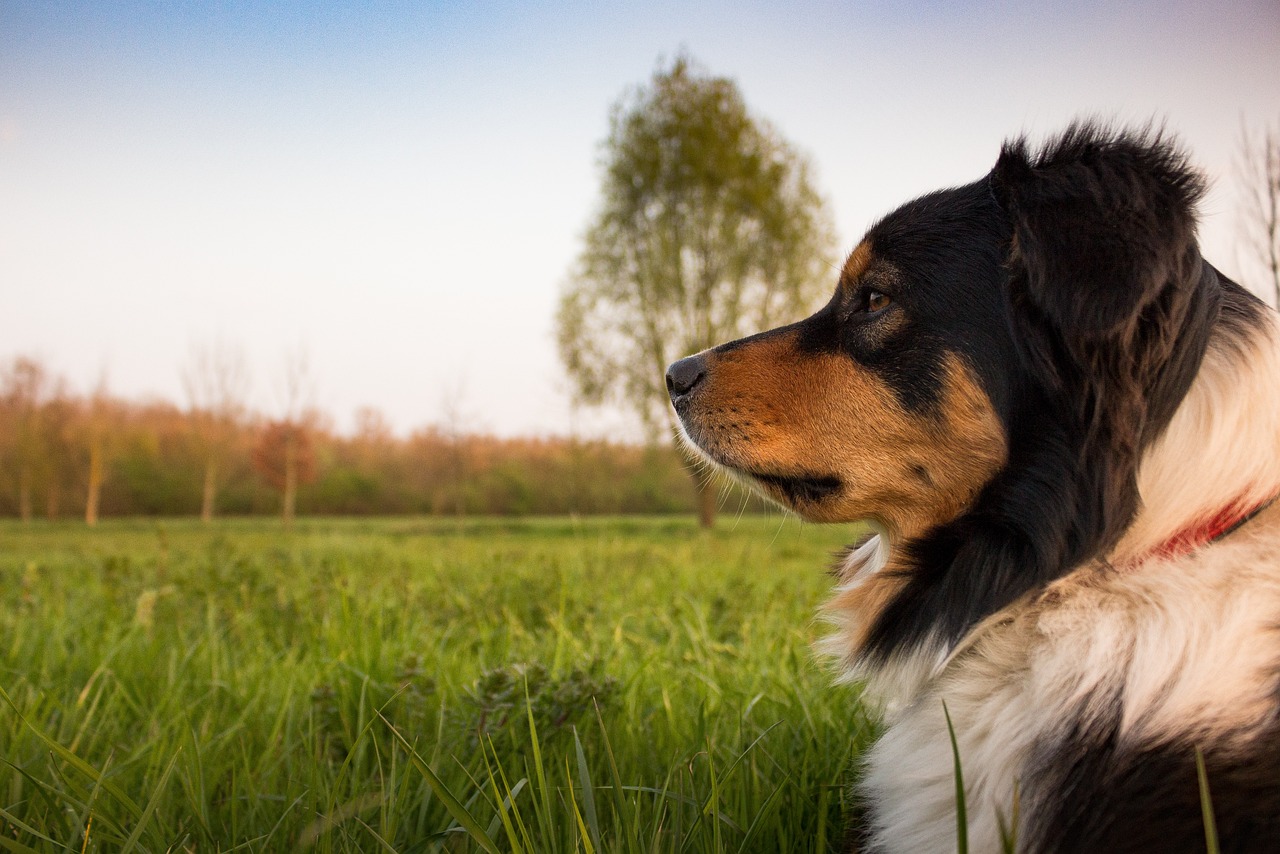
Choosing the Right Spot
When it comes to training your dog to go to their designated spot, the choice of location is crucial. You want to select a spot that not only meets your dog's needs but also enhances the training experience. Think of it as creating a cozy nook for your furry friend, a place where they can feel safe and secure. This is more than just a corner of the room; it's a space that should resonate with comfort and familiarity. But how do you determine the right spot? Let’s dive into some important factors to consider.
First, consider the environment. Is the area too noisy or filled with distractions? Dogs can be easily overwhelmed by loud sounds or bustling activity, which can hinder their ability to focus on training. Ideally, you want a location that is relatively quiet and free from interruptions. For example, if your living room is often filled with guests or the sounds of a television, it may not be the best choice. Instead, a quiet corner in a less trafficked area of your home might be just what you need.
Next, think about the accessibility of the spot. Your dog should be able to reach their designated area easily, without having to navigate around obstacles. If your dog struggles to get to their spot due to furniture or other barriers, it can lead to frustration, both for you and your pet. A clear path to their spot not only makes it easier for them but also reinforces the command you are teaching them.
Another important aspect is whether you prefer an indoor or outdoor spot. Each option has its pros and cons. Indoor spots are usually more controlled, protecting your dog from weather changes and providing a consistent environment. However, outdoor spots may offer fresh air and natural surroundings that some dogs love. Consider your dog's personality when making this decision; some dogs thrive in the outdoors, while others may feel more secure indoors.
Lastly, ensure that the spot is both comfortable and safe. A good spot should have appropriate bedding, such as a soft dog bed or blanket, to make it inviting. You wouldn't want to sit on a hard floor, and neither does your dog! Also, be mindful of safety; if the spot is outdoors, make sure it’s free from sharp objects or hazards that could harm your pet. Creating a welcoming environment is essential for successful training.
In summary, choosing the right spot for your dog is about more than just picking a location. It involves understanding your dog's needs and preferences, ensuring the area is accessible, and creating a space that feels safe and comfortable. By taking the time to select the perfect spot, you set the stage for effective training and a happy, well-adjusted pet.
Location Factors
When it comes to training your dog to go to their designated spot, the environment plays a significant role in your success. A well-chosen location can make all the difference in how quickly and effectively your dog learns this command. First and foremost, consider the noise levels in the area. If your dog's spot is near a busy street or a loud appliance, it may distract them and hinder their ability to focus on the training. Just imagine trying to concentrate on a task while a loud party is happening next door—your dog will struggle to do the same!
Next, think about potential distractions. Dogs are naturally curious creatures, and if their spot is near toys, other pets, or even tempting smells from the kitchen, it might be challenging to keep their attention on the task at hand. To create a successful training environment, choose a spot that minimizes these distractions. You want your dog to associate their spot with calmness and focus, rather than a whirlwind of stimuli pulling them in different directions.
Accessibility is another crucial factor. The spot should be easy for your dog to reach, ensuring they don't feel frustrated or overwhelmed when trying to get there. If your dog has to navigate through a maze of furniture or stairs, they may lose interest or become confused. A clear path to their spot will make it easier for them to understand where they need to go. Think of it like setting up a cozy reading nook for yourself; you wouldn’t want to have to climb over obstacles just to get to your favorite chair!
In summary, when selecting the perfect location for your dog’s spot, keep in mind the following factors:
- Noise Levels: Choose a quiet area to minimize distractions.
- Distractions: Avoid spots near toys, food, or other pets.
- Accessibility: Ensure the spot is easy for your dog to reach.
By paying attention to these location factors, you'll create an ideal training environment that helps your dog learn to go to their spot with ease and confidence.
Indoor vs. Outdoor Spots
When it comes to choosing the perfect spot for your dog, the debate between indoor and outdoor locations can be quite significant. Each option has its own set of advantages and disadvantages that can influence your dog's training experience and overall comfort. Let's dive into what makes each choice unique!
Starting with indoor spots, these areas often provide a sense of security and comfort for your dog. Indoors, your furry friend is shielded from the unpredictable elements of nature, such as rain, wind, and extreme temperatures. Additionally, indoor environments can be enriched with familiar scents and sounds, making it easier for your dog to feel at home. A cozy corner with a soft bed or blanket can be an ideal spot, as it invites relaxation and a sense of belonging.
However, it's essential to consider potential distractions indoors. Things like television sounds, people moving around, or even other pets can divert your dog's attention, making it harder for them to focus on the training process. To combat this, you might want to choose a quieter room or a less-trafficked area of your home where your dog can learn to settle without interruptions.
On the other hand, outdoor spots can offer a completely different training experience. Being outside allows your dog to engage with nature, which can be invigorating and stimulating. Fresh air, sunshine, and the sounds of the outdoors can make training feel like an adventure! However, outdoor spots come with their own challenges. You must consider factors such as noise levels, distractions from other animals or people, and even weather conditions that can impact your dog's comfort and focus.
To help you weigh the pros and cons of each option, here’s a quick comparison:
| Feature | Indoor Spot | Outdoor Spot |
|---|---|---|
| Comfort | High - sheltered from elements | Variable - depends on weather |
| Distractions | Moderate - household noises | High - wildlife, other dogs, people |
| Safety | High - controlled environment | Variable - potential dangers outside |
| Enrichment | Low - familiar but less stimulating | High - engaging with nature |
Ultimately, the choice between an indoor or outdoor spot boils down to your dog's personality and the specific training goals you have in mind. If your dog is easily distracted or anxious, an indoor spot might be more suitable. Conversely, if your dog thrives on adventure and enjoys being outside, an outdoor spot could be the way to go. Either way, ensuring that the chosen spot is safe and comfortable will help your dog learn to go to their designated area with ease.
Comfort and Safety
When it comes to training your dog to go to their spot, are paramount. After all, you want your furry friend to feel at ease in their designated area, which will make the training process much smoother. Think of it as creating a cozy little nook for your dog—a place where they can retreat and feel secure. To start, consider the type of bedding you provide. A soft, padded bed or a favorite blanket can make all the difference in how your dog perceives their spot. Just like we love our comfy couches, dogs appreciate a comfortable area to relax.
Next, ensure that the area is free from hazards. This means checking for sharp objects, toxic plants, or anything that could pose a risk to your pet. If your dog is going to spend time in a specific location, it should be a safe haven. You wouldn’t want your dog to associate their spot with discomfort or danger, right? Additionally, consider the temperature of the spot. If it’s too hot or too cold, your dog may avoid it altogether. For outdoor spots, provide shade in the summer and shelter from the wind or rain in the winter. Indoor spots should be away from drafts and direct sunlight to keep your pup comfortable.
Another essential factor is the environmental noise. Dogs can be surprisingly sensitive to sounds, so choose a spot that is relatively quiet. If your dog is easily startled by loud noises, a calm environment will help them feel more secure. If your home tends to be bustling with activity, consider using a room that’s a bit more secluded for their training. This will help them concentrate and associate their spot with peace and relaxation.
Finally, don’t forget to personalize their spot! Adding a few of their favorite toys or a piece of your clothing can help make the area feel more familiar and inviting. Dogs are creatures of habit, and the more you can make their spot feel like their own, the better. Remember, the goal is to create a space that your dog not only recognizes as their spot but also loves to spend time in. This will significantly aid in the training process and foster a sense of security and comfort for your canine companion.
- How long does it take to train my dog to go to their spot? The time it takes can vary based on your dog's personality and previous training experiences. Consistency and patience are key!
- What if my dog refuses to go to their spot? If your dog seems hesitant, try making the spot more appealing with treats or toys. You may also need to revisit the comfort and safety aspects of the area.
- Can I use a crate as a spot? Yes! A crate can be a great option if your dog is crate-trained and feels secure in that environment.
Setting Up the Training Process
When it comes to teaching your dog to go to their spot, setting up a well-structured training process is absolutely essential. Think of this as laying down the foundation for a beautiful house; without a solid base, everything else can crumble. The first step in this process is to establish a clear command that your dog will associate with going to their designated area. This could be a simple phrase like “Go to your spot!” or “Place!” The key here is consistency; use the same command each time so your dog can easily learn what you expect.
Next, you’ll want to create a routine that incorporates this command into your daily life. Dogs thrive on routine, and having a set schedule will help reinforce their learning. For instance, you could start by incorporating the command during specific times of the day, such as meal times or when guests arrive. This repetition will help your dog understand what is expected of them, making the training process smoother.
Don’t forget to keep the training sessions short and fun! Dogs have a limited attention span, so it’s best to limit each training session to about 5-10 minutes. During these sessions, you can use treats or toys as rewards for successfully going to their spot. This positive reinforcement not only motivates your dog but also strengthens the bond between you two. Remember, training should be a joyful experience for both of you!
As you progress, gradually increase the difficulty by adding distractions or extending the distance between you and the spot. This will help your dog learn to focus and obey the command even when there are other tempting things around. If your dog struggles with this, don’t get discouraged! Training is a journey, and it’s important to celebrate the small victories along the way.
Finally, always end your training sessions on a positive note. Whether your dog successfully goes to their spot or not, give them plenty of praise and affection. This will ensure they associate training with good feelings, making them more eager to participate in the future. By setting up a structured training process with clear commands, consistent routines, and positive reinforcement, you’ll be well on your way to teaching your dog to go to their spot with ease!
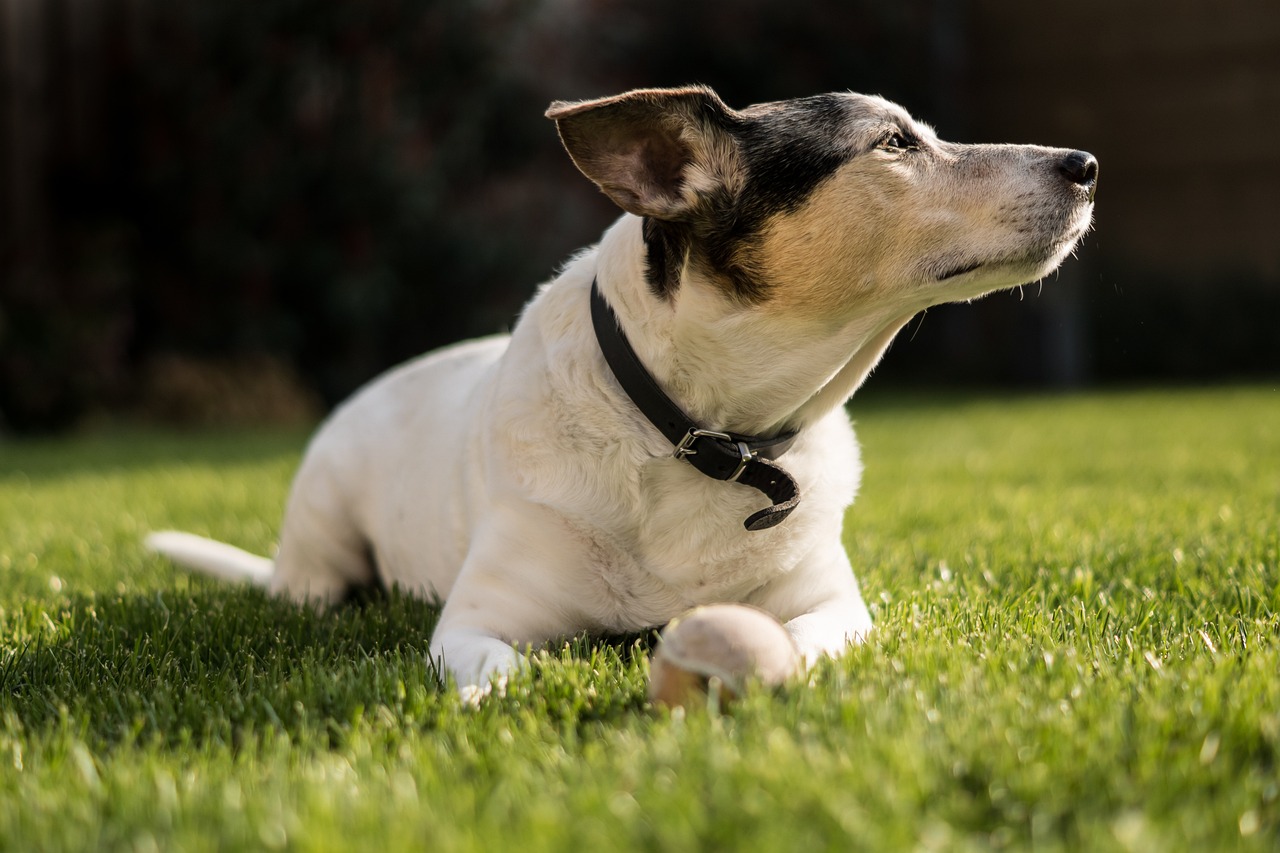
Using Positive Reinforcement
When it comes to training your dog to go to their spot, positive reinforcement is your best friend. This technique focuses on rewarding your dog for good behavior rather than punishing them for mistakes. Imagine trying to learn a new skill; wouldn’t it be more motivating to receive praise and treats rather than facing criticism? That’s the essence of positive reinforcement in dog training. By associating the act of going to their spot with something enjoyable, you create a strong and positive connection in your dog's mind.
To effectively implement positive reinforcement, start by choosing rewards that your dog absolutely loves. This could be their favorite treats, a beloved toy, or even a bit of extra playtime. The key is to ensure that the reward is enticing enough to motivate your dog. For instance, if your dog is a big fan of peanut butter, you might reserve this special treat for when they successfully go to their spot. When they do, shower them with praise and give them the reward immediately. This immediate connection helps your dog understand that going to their spot results in something fantastic!
Timing is crucial in this process. You want to ensure that your dog associates the action of going to their spot with the reward. For example, as soon as your dog steps onto their designated area, say a command like "Spot!" and then reward them. Consistency in your training routine will also yield better results. Make sure to practice this regularly, ideally at the same time each day, so your dog can anticipate and understand what is expected of them.
However, it's not just about treats and toys. Your enthusiasm plays a vital role too! Dogs are incredibly perceptive and can sense your energy. When you act excited and happy about their progress, it encourages them to repeat the behavior. A simple "Good dog!" or a happy dance can go a long way in reinforcing positive behavior. Remember, training should be a fun experience for both of you!
As you progress, you can start to gradually phase out the treats. Once your dog reliably goes to their spot on command, you can reward them intermittently. This keeps the excitement alive and ensures they don’t just perform the action for the treat but because they enjoy the process and the bond you share. In this way, you’re not only teaching your dog where to go but also strengthening your relationship with them.
Lastly, be patient. Training is a journey, and every dog learns at their own pace. Celebrate the small victories along the way, and don’t get discouraged by setbacks. If your dog doesn’t immediately understand what you want, take a step back and reassess your approach. Sometimes, a little tweak in your technique can make all the difference.
- How long does it take to train my dog to go to their spot? - Training duration varies by dog. Some may learn in a few days, while others may take weeks. Consistency and patience are key!
- What if my dog refuses to go to their spot? - If your dog is hesitant, try making the spot more appealing with treats or toys. Also, ensure the spot is comfortable and free from distractions.
- Can I use negative reinforcement instead? - While some trainers use negative reinforcement, positive reinforcement is generally more effective and strengthens the bond between you and your dog.
Timing and Consistency
When it comes to training your dog to go to their spot, timing and consistency are your best friends. Imagine trying to learn a new dance without the rhythm; it would be chaotic, right? The same goes for your furry friend. Dogs thrive on routine, and establishing a consistent training schedule not only helps them understand what is expected but also builds their confidence. So, how do you achieve this?
Firstly, pick specific times throughout the day to work on this training. Whether it's during meal times, after a walk, or just before bedtime, having a set time helps your dog anticipate the training session. This creates a sense of structure that they can rely on. For instance, if you decide to train your dog after their morning walk, they will start associating that time with going to their spot.
Next, it’s crucial to be consistent with your commands and rewards. Use the same phrase each time you want your dog to go to their spot. If you say “Go to your spot!” one day and “Bedtime!” the next, your dog will be confused. Stick to one command, and make sure everyone in the household does the same. Consistency in your approach will reinforce the behavior you want to see.
Moreover, consider the duration of your training sessions. Short, frequent sessions are often more effective than long, drawn-out ones. Aim for about 5-10 minutes of focused training, several times a day. This keeps your dog engaged and prevents them from becoming bored or frustrated. Just like us, dogs can lose interest if the training drags on too long.
Another important aspect is the timing of your rewards. When your dog successfully goes to their spot, reward them immediately with a treat or praise. This instant feedback helps them connect the action with the reward, reinforcing the behavior. Think of it as giving a high-five right after someone scores a goal; it’s all about that timely recognition!
Lastly, keep a training log. This can be a simple table where you jot down when you trained, how long the session lasted, and your dog’s progress. Tracking their progress can help you see what works and what doesn’t, allowing you to adjust your training methods accordingly. Here’s a simple example of what your training log might look like:
| Date | Time | Duration | Notes |
|---|---|---|---|
| 2023-10-01 | 8:00 AM | 10 mins | Dog went to the spot successfully 3 times! |
| 2023-10-02 | 8:00 AM | 5 mins | More distracted today, only went to the spot once. |
In conclusion, remember that are essential elements in your dog’s training journey. By establishing a routine, using the same commands, rewarding them promptly, and keeping your training sessions short and effective, you can create a positive learning environment that will help your dog master the art of going to their spot. So, are you ready to get started?
- How long does it take to train my dog to go to their spot?
Training times can vary based on your dog's age, breed, and previous training experience. Generally, with consistent practice, you can expect to see progress within a few weeks. - What if my dog refuses to go to their spot?
Stay patient! Ensure the spot is comfortable and inviting. You may need to use more enticing rewards or try a different location. - Can I train my dog to go to their spot while there are distractions?
It’s best to start in a quiet environment. Once your dog understands the command, you can gradually introduce distractions.
Common Challenges and Solutions
Training your dog to go to their spot can be an exciting journey, but it’s not without its bumps along the way. Just like learning to ride a bike, your furry friend might wobble a bit before they find their balance. One common challenge is distraction. Dogs are naturally curious creatures, and when they see something interesting—a squirrel, a passing car, or even a crumb on the floor—they might forget all about their training. To tackle this, it’s essential to choose a training time when your dog is less likely to be distracted. Early mornings or quiet evenings can be ideal.
Another hurdle is inconsistency. If you occasionally let your dog ignore the command or don’t reinforce the behavior every time, they might get confused. Dogs thrive on routine and clear expectations. To combat this, establish a consistent training schedule and make sure everyone in your household is on the same page. This means no sneaking treats or allowing your pup to lounge on the couch instead of going to their spot when the command is given!
Sometimes, dogs may feel anxiety about being confined to a specific area. If your dog seems hesitant or stressed about going to their spot, it could be due to a negative association with that area. To solve this, make the spot a fun and inviting place. Use soft bedding, toys, and even the occasional treat to create positive experiences. Over time, your dog will start to see their spot as a safe haven rather than a punishment.
Lastly, some dogs may simply lack the motivation to comply with your commands. In these cases, it’s crucial to understand what motivates your dog—be it treats, playtime, or affection. Incorporate these rewards into your training sessions. For example, if your dog loves a particular toy, use it as an incentive to encourage them to go to their spot. The more excited you are, the more likely they will be to join in on the fun!
In summary, while challenges are part of the training process, they can be overcome with patience, consistency, and a little creativity. Remember, every dog learns at their own pace, so celebrate the small victories along the way!
- How long does it take for my dog to learn to go to their spot? - The time varies by dog, but with consistent training, many dogs can learn within a few weeks.
- What should I do if my dog refuses to go to their spot? - Try to make the spot more appealing with treats or toys, and ensure that training sessions are held in a distraction-free environment.
- Can I use this method for other commands? - Absolutely! The principles of positive reinforcement and consistency can be applied to teach various commands.
Frequently Asked Questions
- What is a 'spot' in dog training?
A 'spot' refers to a designated area where your dog is trained to go when given a command. It helps create a sense of structure and boundaries for your pet, making it easier for them to understand where they should be during specific situations.
- How do I choose the right spot for my dog?
When selecting a spot, consider factors like comfort, safety, and environmental noise. The area should be free from distractions and accessible, ensuring your dog feels secure and relaxed while staying in their designated spot.
- Should I choose an indoor or outdoor spot for training?
It depends on your dog's personality and your living situation. Indoor spots are often quieter and less distracting, while outdoor spots can offer more space. Weigh the pros and cons of each option to find what works best for your furry friend.
- How can I make my dog's spot comfortable?
To create a welcoming environment, use soft bedding, and ensure the area is protected from harsh weather conditions. Adding familiar toys or blankets can also help your dog feel more at home in their designated spot.
- What is positive reinforcement, and how can I use it?
Positive reinforcement involves rewarding your dog for desired behaviors, like going to their spot. Use treats, praise, or playtime as rewards to encourage your dog and reinforce the command effectively.
- Why is timing important in dog training?
Timing is crucial because it helps your dog associate their behavior with the reward. Being consistent with your training schedule and delivering rewards immediately after your dog follows the command will lead to better results.
- What common challenges might I face during training?
Some common challenges include distractions, lack of interest, or confusion about the command. To overcome these, maintain a calm environment, keep training sessions short and fun, and be patient as your dog learns.

